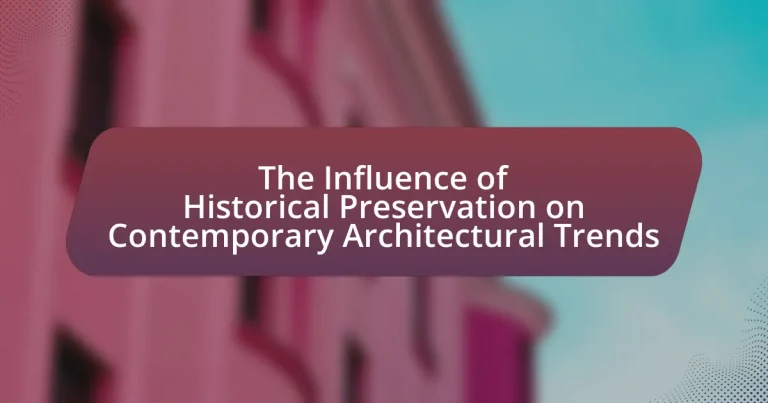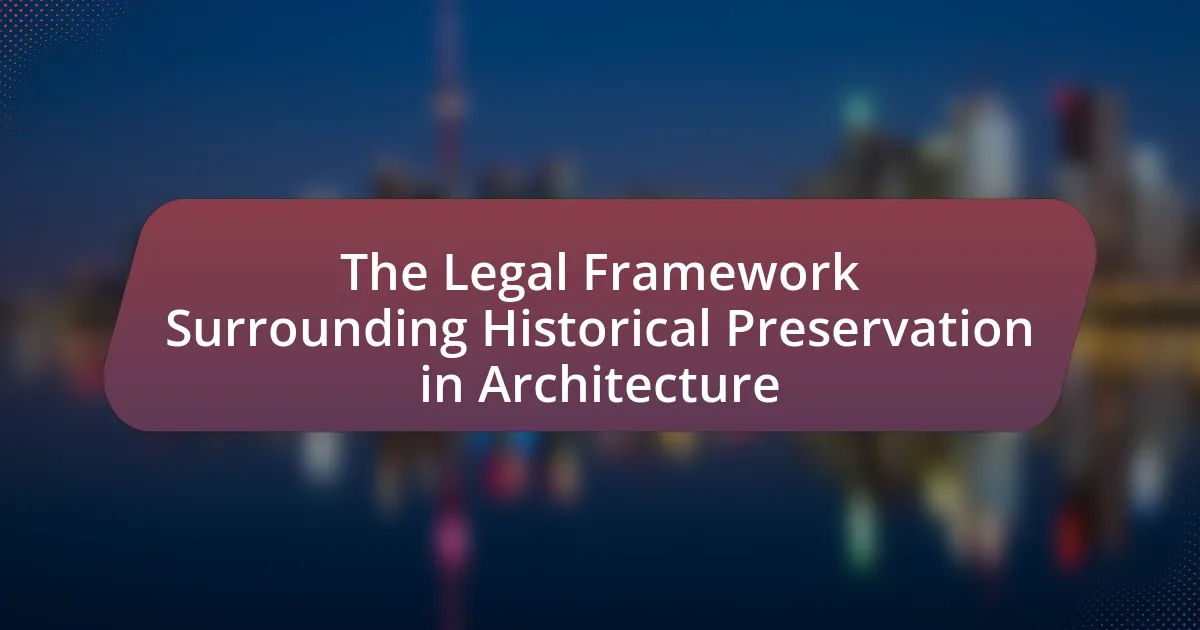The article examines the influence of historical preservation on contemporary architectural trends, highlighting how traditional design elements are integrated into modern structures. It discusses the principles of historical preservation, such as authenticity and sustainability, and their impact on design choices and urban planning. The article also addresses the challenges architects face in balancing preservation with innovation, the role of technology in preservation efforts, and the significance of various architectural styles influenced by historical contexts. Additionally, it emphasizes the importance of historical preservation in maintaining community identity and cultural heritage while contributing to sustainable urban development.

What is the Influence of Historical Preservation on Contemporary Architectural Trends?
Historical preservation significantly influences contemporary architectural trends by promoting the integration of traditional design elements into modern structures. This influence is evident in the increasing popularity of adaptive reuse, where old buildings are repurposed for new functions while retaining their historical character. For instance, the conversion of warehouses into residential lofts in cities like New York showcases how historical aesthetics can enhance contemporary living spaces. Furthermore, the principles of sustainability in architecture often draw from historical practices, emphasizing durability and local materials, as seen in the use of reclaimed wood and brick in new constructions. This blending of old and new not only preserves cultural heritage but also enriches the architectural landscape, reflecting a society that values its history while innovating for the future.
How does historical preservation shape modern architectural practices?
Historical preservation significantly shapes modern architectural practices by influencing design aesthetics, materials, and urban planning. Architects often draw inspiration from historical styles, integrating traditional elements into contemporary designs to create a sense of continuity and cultural identity. For instance, the adaptive reuse of historic buildings allows for the preservation of architectural heritage while meeting modern functional needs, as seen in projects like the Tate Modern in London, which transformed a former power station into a cultural hub. Additionally, regulations and guidelines established for historical preservation ensure that new constructions respect the character of existing neighborhoods, promoting sustainable development and community engagement. This interplay between preservation and innovation fosters a dialogue between past and present, enriching the architectural landscape.
What are the key principles of historical preservation in architecture?
The key principles of historical preservation in architecture include authenticity, integrity, and sustainability. Authenticity ensures that the original materials, design, and craftsmanship are preserved, reflecting the true historical context of the structure. Integrity involves maintaining the original form and features of the building, preventing alterations that could compromise its historical significance. Sustainability emphasizes the importance of using environmentally responsible practices in the preservation process, ensuring that historical buildings can be maintained for future generations. These principles are supported by guidelines from organizations such as the National Park Service, which outlines standards for preservation that prioritize the protection of cultural heritage while adapting to modern needs.
How do these principles influence contemporary design choices?
Historical preservation principles significantly influence contemporary design choices by promoting the integration of traditional aesthetics and sustainable practices into modern architecture. These principles encourage architects to respect and reflect the historical context of a site, leading to designs that harmonize with existing structures and cultural narratives. For instance, the use of local materials and architectural styles rooted in history not only enhances the visual appeal but also fosters a sense of community identity. Research indicates that buildings designed with historical preservation in mind often achieve higher levels of public approval and engagement, as seen in urban revitalization projects where preserved elements attract both residents and tourists.
Why is historical preservation important in today’s architectural landscape?
Historical preservation is important in today’s architectural landscape because it maintains cultural heritage and informs contemporary design practices. By preserving historical structures, communities retain their unique identities and foster a sense of continuity, which is essential for social cohesion. Furthermore, studies show that integrating historical elements into modern architecture can enhance aesthetic appeal and increase property values; for instance, a report by the National Trust for Historic Preservation indicates that historic districts often experience higher economic growth compared to non-historic areas. This demonstrates that historical preservation not only honors the past but also contributes to sustainable urban development and revitalization efforts.
What cultural values are preserved through historical architecture?
Historical architecture preserves cultural values such as identity, heritage, and community. These structures serve as tangible representations of a society’s history, reflecting its artistic, social, and technological advancements. For instance, the preservation of Gothic cathedrals in Europe showcases religious devotion and architectural innovation from the Middle Ages, while traditional Japanese wooden houses embody principles of harmony with nature and craftsmanship. Such buildings not only maintain aesthetic and historical significance but also foster a sense of belonging and continuity within communities, reinforcing cultural narratives across generations.
How does historical preservation contribute to community identity?
Historical preservation contributes to community identity by maintaining and showcasing the unique cultural heritage and historical narratives of a place. This preservation fosters a sense of belonging and continuity among residents, as it allows them to connect with their past and understand their community’s evolution. For instance, studies have shown that communities with preserved historical sites often experience increased civic pride and engagement, as these sites serve as focal points for local events and gatherings. Additionally, the National Trust for Historic Preservation highlights that such efforts can enhance local economies by attracting tourism, which further reinforces community identity through shared experiences and collective memory.
What challenges does historical preservation pose to contemporary architecture?
Historical preservation poses significant challenges to contemporary architecture by imposing restrictions on design, materials, and construction methods. These restrictions often limit architects’ creative freedom, as they must adhere to specific guidelines that protect the historical integrity of existing structures. For instance, in cities with strict preservation laws, new buildings may be required to match the height, scale, and façade of historical buildings, which can hinder innovative architectural solutions. Additionally, the use of modern materials and techniques may be restricted to maintain the authenticity of historical sites, complicating the integration of sustainable practices. This tension between preserving the past and embracing modernity creates a complex landscape for architects, who must navigate regulatory frameworks while striving to meet contemporary needs and aesthetic preferences.
How do architects balance preservation with innovation?
Architects balance preservation with innovation by integrating modern design principles while respecting historical context. This approach often involves adaptive reuse, where existing structures are renovated for new purposes, maintaining their historical significance while incorporating contemporary materials and technologies. For example, the Tate Modern in London transformed a former power station into a leading art museum, preserving its industrial character while introducing innovative exhibition spaces. This method not only honors the past but also meets current functional and aesthetic needs, demonstrating that preservation and innovation can coexist effectively in architectural practice.
What are the common conflicts between preservation and modern needs?
Common conflicts between preservation and modern needs include the challenge of integrating contemporary infrastructure with historical sites, which often requires alterations that may compromise the integrity of the original structures. For instance, the need for modern amenities such as elevators, HVAC systems, and updated safety features can lead to modifications that detract from the historical authenticity of a building. Additionally, zoning laws and regulations aimed at preserving historical sites can restrict development opportunities, making it difficult to meet the demands of urban growth and modernization. These conflicts are evident in cases like the preservation of the historic district in New Orleans, where balancing tourism and local needs often leads to tensions between maintaining heritage and accommodating modern lifestyles.
How does historical preservation influence sustainability in architecture?
Historical preservation significantly influences sustainability in architecture by promoting the reuse of existing structures, which reduces the need for new materials and minimizes waste. This practice conserves resources and energy, as renovating an old building often requires less energy than constructing a new one from scratch. For instance, a study by the National Trust for Historic Preservation found that rehabilitating historic buildings can save up to 50% of the energy typically consumed in new construction. Additionally, preserved buildings often embody durable materials and craftsmanship that contribute to their longevity, further enhancing their sustainability profile.
What role does technology play in historical preservation?
Technology plays a crucial role in historical preservation by enabling the documentation, restoration, and conservation of cultural heritage. Advanced tools such as 3D scanning and digital modeling allow for precise documentation of historical sites, ensuring that details are captured accurately for future reference. For instance, the use of laser scanning technology has been employed in projects like the documentation of the Notre-Dame Cathedral, which suffered significant damage in 2019. This technology not only aids in creating detailed records but also facilitates virtual reconstructions, allowing for informed restoration efforts. Additionally, technologies like climate control systems and materials science innovations help in the preservation of artifacts and structures by mitigating environmental damage. Thus, technology significantly enhances the effectiveness and efficiency of historical preservation efforts, ensuring that cultural heritage is maintained for future generations.
What are the specific architectural styles influenced by historical preservation?
Specific architectural styles influenced by historical preservation include Colonial Revival, Gothic Revival, and Neoclassical architecture. Colonial Revival emerged in the late 19th century, reflecting a renewed interest in America’s colonial past, characterized by symmetrical facades and classical details. Gothic Revival, prominent in the mid-19th century, drew inspiration from medieval European architecture, featuring pointed arches and intricate ornamentation. Neoclassical architecture, rooted in the 18th century, emphasizes grandeur and symmetry, often incorporating elements from ancient Greek and Roman designs. These styles demonstrate how historical preservation shapes contemporary architectural practices by fostering a connection to cultural heritage and historical narratives.
How do these styles reflect historical significance in modern buildings?
Modern buildings often reflect historical significance through the incorporation of architectural styles that pay homage to past eras, such as Art Deco, Gothic Revival, and Mid-Century Modern. These styles are integrated into contemporary designs to evoke a sense of continuity and cultural identity, demonstrating how historical elements can enhance modern functionality. For instance, the use of decorative motifs from the Art Deco period in new skyscrapers not only adds aesthetic value but also connects the structure to the historical narrative of urban development in the early 20th century. This blending of styles serves to remind society of its architectural heritage while addressing current needs, illustrating the ongoing dialogue between past and present in the built environment.
What examples illustrate the fusion of historical and contemporary design?
Examples that illustrate the fusion of historical and contemporary design include the Tate Modern in London and the High Line in New York City. The Tate Modern, originally a power station, integrates its industrial heritage with modern art installations, showcasing how adaptive reuse can blend old structures with contemporary aesthetics. Similarly, the High Line, a repurposed elevated railway, combines historical elements of the rail line with modern landscaping and public art, creating a unique urban space that honors its past while serving current community needs. These projects exemplify how historical preservation can inform and enhance contemporary architectural trends.
What best practices should architects follow when integrating historical preservation?
Architects should prioritize thorough research and documentation of historical contexts when integrating historical preservation. This involves understanding the architectural styles, materials, and cultural significance of the structures involved. For instance, the Secretary of the Interior’s Standards for the Treatment of Historic Properties outlines specific guidelines that emphasize retaining and preserving historic materials and features. Additionally, architects should engage with local communities and stakeholders to ensure that preservation efforts reflect the values and history of the area. This collaborative approach not only fosters community support but also enhances the authenticity of the preservation work. By adhering to these best practices, architects can effectively balance modern design needs with the integrity of historical sites.





